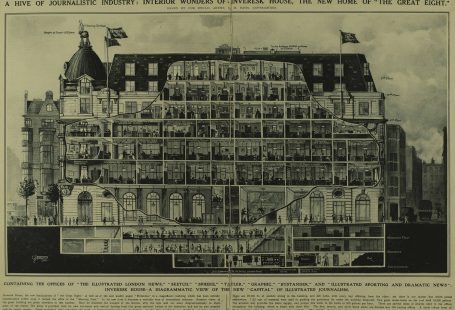I know a land where the wild flowers grow
Near, near at hand if by train you go,
Metro-land. Metro-land.
The above pre-First World War verse written by George R Sims coined the phrase ‘Metro-land’ – that area of north west of Wembley served by what was then called the Metropolitan Railway, and is now known as the Metropolitan Line.
In this blog, using articles found on the British Newspaper Archive, we will explore how the Metropolitan Railway shaped London’s suburbs, and how the suburbia it created, Metro-land, was immortalised by late poet laureate Sir John Betjeman.
Want to learn more? Register now and explore the Archive
New Metropolitan Railway rolling stock | Illustrated London News | 3 Jan 1920
The Metropolitan Railway, from its Baker Street hub, extended north west into the ‘green fields of Middlesex.’ As a pre-1920 map printed in the Harrow Observer shows, the railway’s stations including Preston Road and Rayners Lane serve only ‘farm land’ and there is ‘no Northwick Park.’ It is easy to understand where George R Sims got his inspiration from for his verse; and the Metropolitan Railway soon seized upon his coinage for their own advertising purposes.
Harrow Observer | 16 February 1973
For as the Hayes & Harlington Gazette relates ‘after World War I…housing estates spread like wild flowers along the route of the railway to make Metroland London’s first commuter belt. In the 20 years from 1919 the Metroland Railway Estates Company built some 4,600 houses around the tracks.’
 A stream is diverted for the Metropolitan Railway extension | The Sphere | 26 December 1926
A stream is diverted for the Metropolitan Railway extension | The Sphere | 26 December 1926
The Metropolitan Railway began developing these green fields, but still, in the 1920s and 1930s, this urbanisation was melded with the rural, creating suburbia as we know it today.
A 1921 article in The Sphere relates:
Metro-Land, as it figures on posters, is a singularly delectable place. In real life it is almost equally delightful, a succession of little garden cities developed on estates by the Metropolitan Railway, and linked up with London and one another by an admirable service of electric trains.
It describes the springing up of ‘a pretty little village’ called Kingsbury, now served by the Jubilee Line, as well as the ‘picturesque houses and grass rides’ between Rickmansworth and Chorley Wood.
Retiring Pinner railway worker John Leaver in 1925 describes an equally idyllic lifestyle, reminiscing how ‘In the early days we could run across the road and play a game of skittles between the trains…I always managed to be back two minutes before the train started.’
Meanwhile, the Metropolitan Railway at the British Empire Exhibition in Wembley in 1924-1925 showed off ‘several examples of Metropolitan bungalows and houses,’ encouraging ‘more people to live in Middlesex,’ as the Pinner Observer relates.
Illustrated London News | 24 May 1924
Build it and they will come, and come they did. A 1988 retrospective in the Hayes & Harlington Gazette underlines the power of the Metropolitan Railway’s expansion into rural Middlesex:
If it wasn’t for Metroland, the area might indeed have remained largely rural, but then many of us wouldn’t be here at all. For the development of north west Middlesex between the wars was almost entirely due to the expansion of the Metropolitan Railway. Metroland was born.
Whilst Metro-land blossomed, and slipped into the prosaic of the everyday, it was to be immortalised by the pen of poet laureate Sir John Betjeman in the 1950s, and then again by his famous 1973 documentary, Metro-land.
Gaily into Ruislip Gardens
Runs the red electric train,
With a thousand Ta’s and Pardon’s
Daintily alights Elaine;
Hurries down the concrete station
With a frown of concentration,
Out into the outskirt’s edges
Where a few surviving hedges
Keep alive our lost Elysium – rural Middlesex again.
The Harrow Observer in 1973 anticipates the documentary, which was set to use ‘the Met Line as a vehicle to tell the story of the wide variety and character of the suburbs that grew alongside it in the 1920s and 1930s.’
And it precisely was the prosaic and the everyday that Betjeman delighted in, the normal activities of suburbia that the Metropolitan Railway had made possible, the ‘car washing, lawn-mowing and gardening.’
Sir John Betjeman | Harrow Observer | 23 February 1973
His documentary looked at the styles of 1920s and 1930s architecture in Suffolk Road and Church Drive in Harrow, and highlighted ‘the stained glass in the front doors and landing lights of houses in Northumberland Road, Church Drive, Lincoln Road and Heath Road,’ also in Harrow.
And nowadays, the green fields of rural Middlesex are long departed, but what remains is the magic of the enterprising legacy of the Metropolitan Railway, and demonstrates how transport shaped the development of London.









